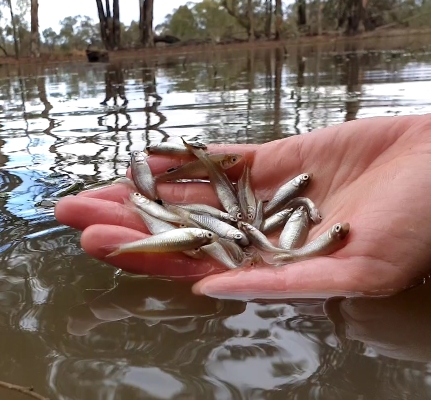Water for the environment
Water for the environment, also known as 'environmental water', is water that is released into rivers, floodplains, wetlands and estuaries to improve waterway health and protect environmental values. The development and implementation of Victoria’s environmental watering program is a collaborative process between state and commonwealth government agencies, including land managers and water corporations. Understanding how to maximise the benefits of environmental watering requires the support of ecological data and underpins the decision-making processes of this program. In view of this, the Victorian Government established the Victorian Environmental Flows Monitoring and Assessment Program (VEFMAP) in 2005, which is being undertaken in a series of stages.
Victorian Environmental Flows Monitoring and Assessment Program (VEFMAP)
VEFMAP represents a large-scale, long-term monitoring program designed to assess ecosystem responses to changes in flow regime in regulated Victorian rivers that receive environmental water. Monitoring for the program commenced in 2007 and is ongoing. ARI has been the delivery partner since 2015.
- Information on each stage is presented below with associated resources. For more information about VEFMAP contact:
magdalena.nystrad@deeca.vic.gov.au (VEFMAP Program Coordinator, ARI)
zeb.tonkin@deeca.vic.gov.au (fish monitoring, ARI)
chris.jones@deeca.vic.gov.au (vegetation monitoring, ARI)
VEFMAP Stage 7 (2020-2024)
Following VEFMAP Stage 6, the approach to management and governance was revised, seeking to have a more coordinated and combined approach to program delivery and governance. A new Program Steering Committee and a new Independent Scientific Review Panel (ISRP) were established with revised Terms of Reference and membership. Extensive consultation has occurred with key stakeholders within catchment management authorities and the Victorian Environmental Water Holder. A suite of project proposals has been developed, reviewed and prioritised according to stakeholder and scientific input.
The following projects, within the Fish and Vegetation themes are now underway. These projects vary in terms of when they commenced, their size and timeframe (i.e. some are short term, desk-based review projects, while others are longer-term and involve field based monitoring).
The VEFMAP fish theme continues the long-term annual fish condition monitoring ((PDF, 2.7 MB), (DOCX, 22.4 KB)) to assess population status and trends. In addition, there are five other projects which involve:
- development of population models for key species to assess flow management outcomes and opportunities for refinement ((PDF, 2.5 MB), (DOCX, 22.5 KB))
- identification of key flow and habitat needs of early life stages of fish and decapods and how flows can be managed to benefit such species ((PDF, 2.0 MB), (DOCX, 22.2 KB))
- investigation of the effect of flows on downstream migration of eels ((PDF, 1.7 MB), (DOCX, 21.8 KB))
- assessment of the links between flows and recruitment of River Blackfish and
- a desktop review of low flow recommendations for fish within Seasonal Watering Plans and related documents.
The VEFMAP vegetation theme includes four projects which involve:
- quantification of the effects of flows (and non-flow factors) on waterway vegetation ((PDF, 3.3 MB), (DOCX, 26.1 KB))
- comparing flow and non-flow drivers of riparian vegetation communities and their interactions ((PDF, 651.2 KB), (DOCX, 54.3 KB))
- evaluation of the impact of environmental flows on reproduction and recruitment of riparian vegetation and
- evaluation of the importance of summer/autumn low flows for aquatic vegetation recruitment ((PDF, 2.7 MB), (DOCX, 22.4 KB)).
VEFMAP Stage 6 (2016-2020)
Stage 6 of the program was developed following comprehensive engagement across stakeholders including DEECA, Victorian catchment management authorities, the Victorian Environmental Water Holder, an Independent Review Panel and consultants.
Its core objectives were to: demonstrate ecological outcomes of environmental water management; fill knowledge gaps to improve planning, delivery and evaluation of environmental water management; and collect data required for reporting under the Murray–Darling Basin Plan.
Key features of Stage 6 included a rigorous scientific approach, strong communication, particularly with waterway managers, and a focus on sharing findings in a timely manner to support and inform improved management of environmental water. This stage included an increased focus on intervention-based monitoring to better understand and confirm fish and vegetation responses to environmental flow events.
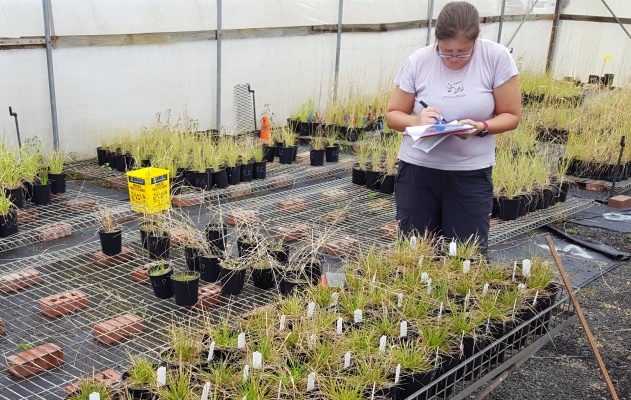
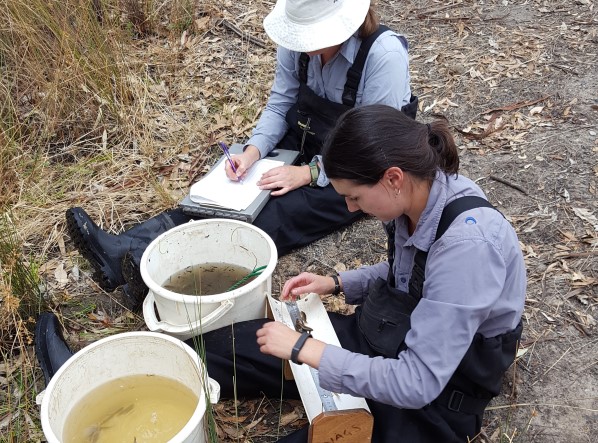
The Stage 6 final report provides a synthesis of the approach taken, key findings and achievements and includes summaries for all core areas of monitoring and research and are available below:
- Tonkin, Z., Jones, C., Clunie, P., Vivian, L., Amtstaetter, F., Jones, M., Koster, W., Mole, B., O’Connor, J., Brooks, J., Caffrey, L. and Lyon, J. (2020) Victorian Environmental Flows Monitoring and Assessment Program. Stage 6 Synthesis Report 2016-2020. (PDF, 7.4 MB) Arthur Rylah Institute for Environmental Research Technical Report Series No. 316. Department of Environment, Land, Water and Planning, Heidelberg, Victoria
(accessible version (DOCX, 10.6 MB))
A brochure has also been produced to summarise Stage 6 and its achievements:
- VEFMAP brochure Stage 6 - results 2016-2020 (PDF, 2.8 MB)
(accessible version (DOCX, 35.2 KB))
Two webinar videos showcase the research findings of VEFMAP Stage 6 and can be found here::
VEFMAP Stage 6 Showcase – Part 1 – Vegetation outcomes and management implications
VEFMAP Stage 6 Showcase – Part 2 – Fish outcomes and management implications
Supplementary materials provide further detailed monitoring and research outcomes that support the final report. These are presented as a series of ARI unpublished client reports and journal articles:
ARI unpublished client reports
- O’Connor, J., et al. (2020) Managing river flows to enhance upstream dispersal and retention of Golden Perch in a highly regulated lowland river system.
- Jones, M.J., et al. (2020) Environmental flows cue fish movement and improve fishway functionality: case studies from a semi-arid river-floodplain system.
- Amtstaetter, F. and Koster, W. (2020) VEFMAP Stage 6: Long term fish community monitoring in the Thomson and Glenelg rivers.
- Harris, A., et al. (2020) Using Otolith Microchemistry to Assign Natal Origin to Juvenile Murray Cod.
- Jones, C.S. et al. (2020) Environmental flows help structure fish and vegetation communities in a regulated semi-arid intermittent stream system.
- Jones, C.S. et al. (2020) Evaluating the influence of environmental flows on vegetation in regulated rivers.
- Jones, C.S. et al. (2020) Understanding the links between environmental flows and soil moisture in waterways to improve vegetation condition.
- Jones, C.S. et al. (2020) Vegetation recruitment in river channels and the role of environmental flows on plant germination.
- Todd, C., et al. (2020) Predicting long-term population responses by Murray Cod and Silver Perch to flow management in the Goulburn and Campaspe rivers: a stochastic population modelling approach.
- Vivian, L. et al. (2020) Drivers of the distribution and community composition of riparian vegetation in regulated rivers of Victoria.
Journal articles:
- Amtstaetter, F. and Suter, S. (2020) Environmental flow releases trigger spawning of a threatened fish: Research insights and publication enhance management, credibility and relationships. Aquatic Conservation: Marine and Freshwater Ecosystems 30(9): 1723-1726
- Amtstaetter, F., Tonkin, Z., O'Connor, J., Stuart, I., and Koster, W. (2021) Environmental flows stimulate the upstream movement of juvenile diadromous fishes. Marine and Freshwater Research 72(7): 1019-1026
- Amtstaetter, F., Yen, J., Hale, R., Koster, W., O'Connor, J., Stuart, I. and Tonkin, Z. (2021) Elevated river discharge enhances the immigration of juvenile diadromous fishes into temperate coastal rivers. Journal of Fish Biology 99(1): 61-72
- Kitanovic, V. et al. (2023) Riparian and terrestrial grasses display unexpected tolerance to cool-season inundation. Wetlands Ecology and Management
- Koster, W.M., Amtstaetter, A., Dawson, D., Coleman, R. A. and Hale, R. (2020) Environmental influences on the juvenile migration of the threatened amphidromous Australian grayling (Prototroctes maraena). Marine and Freshwater Research.
- Koster, W.M., Stuart, I., Tonkin, Z., Dawson, D. and Fanson, B. (2020) Environmental influences on migration patterns and pathways of a threatened potamodromous fish in a regulated lowland river network. Ecohydrology
- Main et al. (2022) Warmer water temperatures exacerbate the negative impacts of inundation on herbaceous riparian plants. Freshwater Biology.
- Pereirra, M., Greet, J. and Jones, C. (2021) Native riparian species dominate the soil seedbank of in-channel geomorphic features of a regulated river. Environmental Management 67: 589-599
- Tonkin, Z. Yen, J., Lyon, J., Kitchingman, A., Koehn, J.D., Koster, W.M., Lieschke, J., Raymond, S., Sharley, J., Stuart, I. and Todd, C. (2021) Linking flow attributes to recruitment to inform water management for an Australian freshwater fish with an equilibrium life-history strategy. Science of The Total Environment 752: 141863
- Vivian, L., Greet, J. and Jones, C.S. (2020) Responses of grasses to experimental submergence in summer: implications for the management of unseasonal flows in regulated rivers. Aquatic Ecology
- Yen, J., Thomson, J., Lyon, J., Koster, W., Kitchingman, A., Raymond, S., Stamation, K. and Tonkin, Z. (2021) Underlying trends confound estimates of fish population responses to river discharge. Freshwater Biology 66(9): 1799-1812
Fact sheet:
- VEFMAP fact sheet Stage 6 - Murray Cod, flows and recruitment (PDF, 283.4 KB)
(accessible version (DOCX, 2.3 MB))
A citizen science component was also undertaken where recreational fishers contributed fish ear bones (otoliths) from the fish they caught for the dinner table. This was added to existing data that will be analysed during Stage 6.
Over the four years of VEFMAP Stage 6, numerous outputs have been produced.
At the commencement of the stage, the following fact sheets, poster, monitoring manuals and video detailed the development, objectives and approach:
- VEFMAP Fact sheet Stage 6 (PDF, 906.7 KB)
(accessible version (DOCX, 5.0 MB)) - VEFMAP Poster Stage 6 - Overview (PDF, 4.4 MB)
- VEFMAP Stage 6 monitoring manual Part A - Program context and rationale (PDF, 2.2 MB)
(accessible version (DOCX, 2.1 MB)) - VEFMAP Stage 6 monitoring manual Part B - Program design and monitoring methods (PDF, 2.3 MB)
(accessible version (DOCX, 4.5 MB))
A short video on VEFMAP Stage 6 is available on the DEECA YouTube channel and can also be viewed below:
Each year, annual reports (request available from research.ari@deeca.vic.gov.au) and fact sheets outlining progress were prepared:
- VEFMAP Fact sheet Stage 6 - Project update 2019 - Campaspe River vegetation 2018-2019 (PDF, 1.3 MB)
(accessible version (DOCX, 3.9 MB)) - VEFMAP Fact sheet Stage 6 - Project update 2019 - Glenelg and Wannon Rivers vegetation 2018-2019 (PDF, 1.3 MB)
(accessible version (DOCX, 3.4 MB)) - VEFMAP Fact sheet Stage 6 - Project update 2019 - West Gippsland vegetation 2018-2019 (PDF, 1.4 MB)
(accessible version (DOCX, 3.9 MB)) - VEFMAP Fact sheet Stage 6 - Project update 2019 - Wimmera River tributaries vegetation 2018-2019 (PDF, 1.0 MB)
(accessible version (DOCX, 4.4 MB)) - VEFMAP Fact sheet Stage 6 - Project update 2019 - Yarra and Watts Rivers tributaries vegetation 2018-2019 (PDF, 1.2 MB)
(accessible version (DOCX, 3.4 MB)) - VEFMAP Fact sheet Stage 6 - Project update 2019 - Northern rivers fish 2018-2019 (PDF, 562.6 KB)
(accessible version (DOCX, 5.1 MB)) - VEFMAP Fact sheet Stage 6 - Project update 2019 - Southern rivers fish 2018-2019 (PDF, 936.8 KB)
(accessible version (DOCX, 3.6 MB))
- VEFMAP Fact sheet Stage 6 - Project update 2018 - Campaspe River vegetation 2017-2018 (PDF, 1.0 MB)
(accessible version (DOCX, 2.6 MB)) - VEFMAP Fact sheet Stage 6 - Project update 2018 - Loddon River vegetation 2017-2018 (PDF, 1.1 MB)
(accessible version (DOCX, 1.8 MB)) - VEFMAP Fact sheet Stage 6 - Project update 2018 - Moorabool River vegetation 2017-2018 (PDF, 1.4 MB)
(accessible version (DOCX, 3.5 MB)) - VEFMAP Fact sheet Stage 6 - Project update 2018 - Wimmera River tributaries fish and vegetation 2017-2018 (PDF, 1006.1 KB)
(accessible version (DOCX, 1.8 MB)) - VEFMAP Fact sheet Stage 6 - Project update 2018 - Northern rivers fish 2017-2018 (PDF, 592.6 KB)
(accessible version (DOCX, 1.4 MB)) - VEFMAP Fact sheet Stage 6 - Project update 2018 - Southern rivers fish 2017-2018 (PDF, 695.7 KB)
(accessible version (DOCX, 826.7 KB))
- VEFMAP Fact sheet Stage 6 - Project update 2017 - Vegetation (PDF, 1.0 MB)
(accessible version (DOCX, 4.9 MB)) - VEFMAP Fact sheet Stage 6 - Project update 2017 - Northern rivers fish (PDF, 458.7 KB)
(accessible version (DOCX, 959.4 KB)) - VEFMAP Fact sheet Stage 6 - Project update 2017 - Southern rivers fish (PDF, 1.0 MB)
(accessible version (DOCX, 4.6 MB)) - VEFMAP Fact sheet Stage 6 - Project update 2017 - Vegetation monitoring planned for 2017-2018 (PDF, 383.6 KB)
(accessible version (DOCX, 726.6 KB))
VEFMAP Stage 5 (2015-2016)
During Stage 5, DEECA's Water and Catchments worked with ARI and the University of Melbourne to review and analyse data collected through VEFMAP and other complementary research, and to explore the relationship between environmental water releases and ecological responses of native fish and vegetation. This provided valuable baseline information to support management decisions. Findings include:
- confirmation of the threatened status of 11 native fish species, and of the dominance of the non-native Carp.
- changes over time in abundance and distribution of certain native and non-native fish species.
- identification of ecological responses to environmental flows during regional case studies of Australian Grayling, Golden Perch and Silver Perch (see fact sheets).
- reduced encroachment of terrestrial vegetation into river channels in response to prolonged periods of inundation.
- increased abundance of native riparian vegetation in response to short periods of inundation.
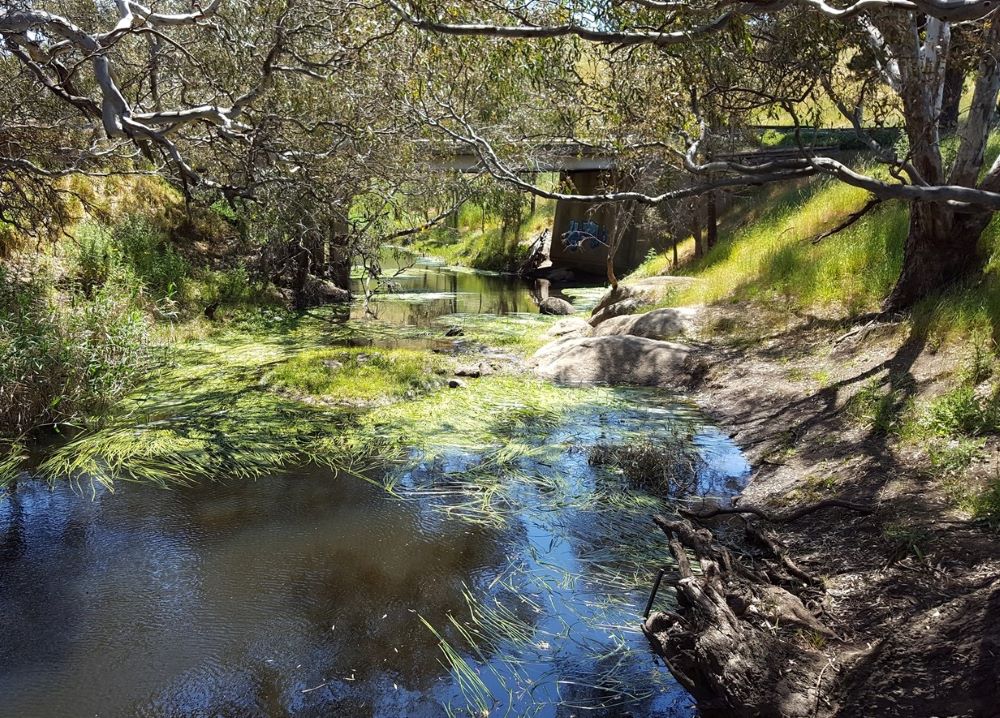
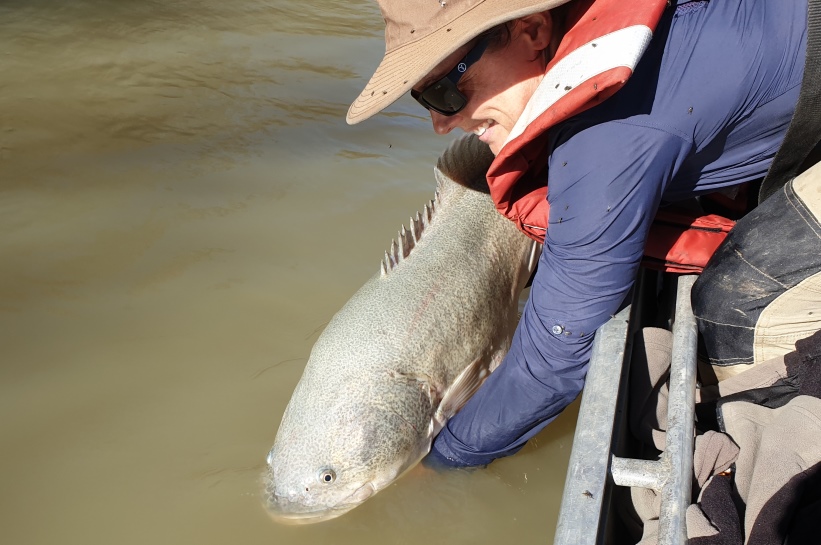
ARI has developed four fact sheets that summarise key results:
- VEFMAP Fact sheet 1: Benefits of environmental water (PDF, 410.3 KB)
(accessible version (DOCX, 299.2 KB)) - VEFMAP Fact sheet 2: Australian Grayling migration (PDF, 561.4 KB)
(accessible version (DOCX, 495.1 KB)) - VEFMAP Fact sheet 3: Australian Grayling spawning (PDF, 436.7 KB)
(accessible version (DOCX, 664.0 KB)) - VEFMAP Fact sheet 4: Golden Perch spawning (PDF, 460.4 KB)
(accessible version (DOCX, 997.2 KB))
VEFMAP Stages 1-4 (2005-2014)
Following the development phase of the program (Stages 1 and 2), monitoring commenced in eight regulated rivers in 2007 (Stage 3, 2007–2016; coordinated by Jacobs). Stage 4 involved a detailed analysis of VEFMAP data through to 2012 (led by The University of Melbourne), as well as a full program review (led by Peter Cottingham and Associates).
ARI has been involved in a range of projects regarding the benefits of environmental flow:
- Amtstaetter, F., O'connor, J., and Pickworth, A. (2016) Environmental flow releases trigger spawning migrations by Australian grayling Prototroctes maraena, a threatened, diadromous fish. Aquatic Conservation: Marine and Freshwater Ecosystems 26: 35–43
- Amtstaetter F., Dawson D. and O’Connor J. (2015) Improving our ability to collect eggs of the threatened Australian grayling, Prototroctes maraena. Marine and Freshwater Research 66: 1216-1219
- Tonkin, Z., Kitchingman, A., Lyon, J., Kearns, J., Hackett, G., O'Mahony, J., Moloney, P.D., Krusic-Golub, K. and Bird, T. (2017) Flow magnitude and variability influence growth of two freshwater fish species in a large regulated floodplain river. Hydrobiologia 797: 289-301
- Koster, W.M., Crook, D.A., Dawson, D.R., Gaskill, S. and Morrongiello, J.R. (2017). Predicting the influence of streamflow on migration and spawning of a threatened diadromous fish, the Australian Grayling Prototroctes maraena. Environmental Management
- Koster W. M., Amtstaetter F., Dawson D. R., Reich P. and Morrongiello J. R. (2016) Provision of environmental flows promotes spawning of a nationally threatened diadromous fish. Marine and Freshwater Research 68: 159-166
- Koenh, J., Balcombe, S. and Zampatti, B. (2019) Fish and flow management in the Murray-Darling Basin: Directions for research. Ecological Management and Restoration 20(2): 142-150
- Stuart, I., Sharpe, C., Stanislawski, K., Parker, A. and Mallen-Cooper, M. (2019) From an irrigation system to an ecological asset: adding environmental flows establishes recovery of a threatened fish species. Marine and Freshwater Research 70(9): 1295-1306
- Tonkin, Z. et al. (2019) Hydrology and water temperature influence recruitment dynamics of the threatened silver perch Bidyanus bidyanus in a regulated lowland river. Marine and Freshwater Research 70(9): 1333-1344
Page last updated: 15/05/25
